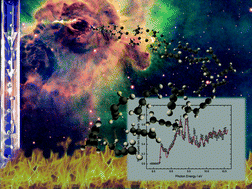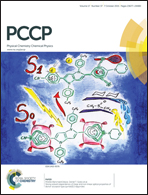Flow tube studies of the C(3P) reactions with ethylene and propylene†
Abstract
Product detection studies of C(3P) atom reactions with ethylene, C2H4(X1Ag) and propylene, C3H6(X1A′) are carried out in a flow tube reactor at 332 K and 4 Torr (553.3 Pa) under multiple collision conditions. Ground state carbon atoms are generated by 193 nm laser photolysis of carbon suboxide, C3O2 in a buffer of helium. Thermalized reaction products are detected using tunable VUV photoionization and time of flight mass spectrometry. For C(3P) + ethylene, propargyl (C3H3) is detected as the only molecular product in agreement with previous studies on this reaction. The temporal profiles of the detected ions are used to discriminate C(3P) reaction products from side reaction products. For C(3P) + propylene, two reaction channels are identified through the detection of methyl (CH3) and propargyl (C3H3) radicals for the first channel and C4H5 for the second one. Franck–Condon Factor simulations are employed to infer the C4H5-isomer distribution. The measured 1 : 4 ratio for the i-C4H5 isomer relative to the methylpropargyl isomers is similar to the C4H5 isomer distribution observed in low-pressure flames and differs from crossed molecular beams data. The accuracy of these isomer distributions is discussed in view of large uncertainties on the photoionization spectra of the pure C4H5 isomers.


 Please wait while we load your content...
Please wait while we load your content...